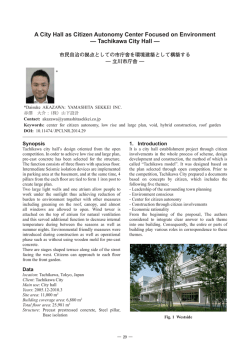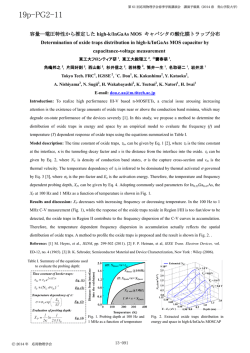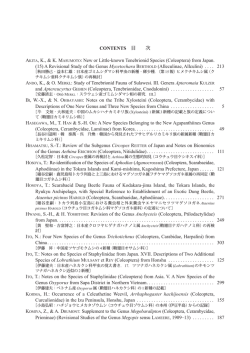
Trans. Proc. Palaeont. Soc. Japan. NS, No.40, pp.329
Trans. Proc. Palaeont. Soc. Japan. N.S., No.40, pp.329-336, pl.38, Nov.30, 1960 391. ON THE NEW NYMPHAEACEAN PLANT FROM THE OMICHIDA NI BED (CRETACEOUS SYSTEM). ISHIKAWA PREFECTURE. CENTRAL JAPAN* IDEKUNI MATSUO H GeologicalInstitute, Kanazawa University 石 川 県 大 道 谷 層(白 亜 系)に 産 出 した ヒ ツ ジ グ サ 科 の 新 種 に つ い て:北 か ら暁 新 世 の 湖 成 層 に 多 産 す る 小 型 水 生 植 物 と し てTrapa? BELL(1949)がNymphaeites angulatusと 細 か い 凹 み が 見 ら れ る こ と と,主 米 大 陸の 白 亜 紀 microphyllaが あ る 。 こ の種 を 改 名 した 。 こ の種 の 特 徴 は 葉 片 の 印 象面 に丸 い 葉 脈 が 葉 柄 の 先 端 附 近 か ら 放 射 状 に 出 て,細 葉 脈 が多 角形 の 鶴 日 を 示 す 型 な とて あ る 。 大 道 谷 谷 峠 ト ン ネ ル 附 近 産 の も の を これ に 比 較 す る と 稍 々 小 型 で あ る 点 と 、 産 川 の 層 準 が 占 い 点 が 異 な っ て い る.葉 片 の 印 象 かTnapuよ pelloidesと 称 す る.尚.北 ?imiiはN.angulatusにL和 ineqtilateralisばN.trapelloides.ボ Dicolylophyllum る とTable2の り も 寧 ろTrapellaに 似 て い る の でN.tran- 海 道 、 岩 手県 久 慈 地 方 の 上部 白 匝紀 層 に 産 出 せ るGlossozamites 歌 山 県 湯 次町 附 近 の 下 部 百亜 紀 層 に 産 出L.たSagenopteris? ル トガ ル の 上 部 白亜 紀 層 か ら喚 新 cercifarmeはN.cereiformisと 様 に な り.北 夫 々改 名 ず る.又 世の 岩 層 に 産 出 す る 、 夫 々の産 出層 準 を 標 め 半 球 白 亜 系 の 湖 成 層 の 対比 に 役 立 つ の で ば な い か と 思 う. 松 Our knowledge on the Nymphaeaccan plants of the Cretaceous age of our country is limited. and the only fossil I have hitherto described is Nelunibo orientalis in the Asuwa Flora of Fukui Prefecture (1951: pp.155-158, PI. XX). In this note I am going to describe an additional occurrence represented by small leaves more recently discovered. The materials originated in the Omichidani bed at road side near the tunnel of Tanittige, Shiramine-Mura. IshikawaPrefecture mens had been collected our Geological Institute: **In 1951, I collected speci- by N. Fun he, in 1956. re ported these specimens as Sagenopteris sp. in his graduation thesis of the Master *Read Nov . 30. 1957: received Oct.23. 邦 genoMeris sp. and advised me to reexamine the specimens more closely. My conclusion is that the fossil plant is AigniPkaeiles tropelloides nov. sp. instead of a Sagenopteris. Before writing on this report. I wish 石田u県石 川都 白 峯 村 谷峠) of Central Japan.**These 秀 course in Science in the Institute of Geology and Palaeontology. Tohoku Universily in Sendai. When I had an opportunity of studying in the laboratory of Prof. E. KONNO of the Tohoku University in 1957, as a scholarship researcher of the Educational Department. Prof: KONNO had not been convinced of Fun's identification of Sa- Introduction -Gun .Ishikawa 尼 leaves sp., and considered them many to be of the Tertiary specimens of these period. In small leaves and 329 needle sp, and Pseneloisuga? a few leaves of Ginkgo and Tasoilitim? sp. etc. 1959. some Sinus some students. of 1959, with digitata. Sequoia sp. were collected by me 330 Hidekuni to express my sincere thanks to Prof. KON'NO.for the kind and valuable advice. guidance and generous provision of the material. And also to Dr. I. HAYASAKA, the president of Shimane University in Matsue. for critically reading this manuscript. MATSUO ings Geological Note As regards the Omichidani Bed. Mr.S. of Chiba University considered MAEDA it a formation of the Akaiwa Group belonging to the Jurasso-Cretaceous System (1952: p.316). but Messrs. S. Expo andM . AMAKO (1952; p.317) regarded it younger Cretaceous in age by its contents of fossil plants. collected by Prof. T. KORAYASHtof Tokyo University and ore recently. the members of the M Ka. nazawa University made observations that the Omichidani bed unconformably lies on the Akaiwa (loop. Thus, I like to agree with Messrs. ENDOand AMANOS opinion with respect to the age of the flora. They reported some fossils as follows Cladophiebisd.'rigida HDER Saurnoplerissp. Ostitundasp. issoula N and b spp. Clinkirerars digifata (BRONGNLART) HEER Sequoitessiniihiaua HEER Sequoiahelrrophilla VELENOVSRY Trapa (Trapello) sp. Nyssidaen,sp. Carpolithussp. It is when I described Nelumbo orienalis from the upper reaches of the t Asuwa-Gawa, Fukui Prefecture, that I proposed to establish the Asuwa Flora. It contains many species of plants (H.MATSUDA and S. Klux: 1953:p. 324). Follow- are unknown. the locality of these plant fossils is among them:** Text-fie. 1. Locality map of Nymphaeites trapelloides in the Omichidani. These members of the Asuwa Flora have a very close resemblance to the fossil plants of Omichidani bed, and are similar to those of the upper Cretaceous floras of Hokkaido (S. Expo: 1925: p.59), Iwate Prefecture in Honshu (Y. SASSA: ** This *But recognized Osontizelo asumenses noc. sp. Clacluradthis frigida (HEER) SEWARD C. sp. ilssonia orientalis N HEER ibbsei (NEWBERRY) N. g NEWBERRT N. acumimata (PREAL) GOPPERT asnuensis nov. sp. N. Cf. Nilssonia sachalinensis KRYSHTOFOVICB & SAIKOVSKAYA Sequoia sp.(Cf. Sequoia reiclanbarhi VELENOVSKY Sequoia sp. (cones) Taxodium sp. (Taxodium dislhicion?) Nelainbo orienialis MATEUO phaeiles sagenopleroides Nym nov. sp. Phylliles SP. (Quercus? sp) Phylliles sp. Menispermiles sp Carpoliihns sp. (Cycadalean seedg) C. sp. (Nissiaimno-tyPe) in the flora Science will he reported Reports by of Kanazawa me soon Univer- 397. On the Neu. Nymphaeacean 1932; p.429). South-Korea D. TATEIWA 1934; p.193). North Saghalin H. YABE 1927'; p.32t Alaska (A. HOLLICK: 1930; pp.18-16. 24-25. 26. 28-30), Western Canada (W. A. BELL: 1949: pp.16-25. Portugal C. TEIXEIRA: 1948 pp.33-116), etc. Description of Species DICOTYLEDONEAK Order Plant from the Omichidani 331 Nelumbites BERRY.-" This genus is a small aquatic plant and is known to occur abundantly in the Northern Hemisphere ranging from the Upper Cretaceous to the Palaeocene; of this genus there are forms such as Trapa. mwrophylla LESQUERELW in North (?) America. Dicotylophyllum ceriforme SAPORTA in Portugal, and Glossozamiles (?) imaii SNDO in Hokkaido and in lwate Prefecture. Ranales Family Nymphaeaceae Nym phaeites trapelloides PI. 38, figs. Genus Bed nay. sp. Text-figs. a-d. Nymphaeites (STERNIIERG)BEII, 19.19 Description Leaves small, detached. peltate and rounded form, vary in size According to the text-book of GOTIAN from 7 to 20 mm long and 4 to 17 mm wide, somewhat enlarged upwards markand WEALAND (195-1) p.387, the Nymhaeites in the family Nymphaeaceaep is ed by many line and rounded pits; fine explained as "Solche nicht naher bestimmserration in an upward margin of leaf; baren Rhizome. Blaner and Ftuchte base obtuse and pet ioled nervation ter erden me ist als Nymphaears STFRNBERG w nate from the petiole, areolal ion distinct. like pentagonal or hexagonal meshedbezeichnet." Thus, this genus had been established form. by STERSBERGfor the rhizomes: but most This species is seen from the descriprecently. BELL emended STERNBERG'SNymtion given above to agree with Nymphaeites angulatus (NEWBERRY) BELL from phaeites. and remarked as follows: the genus comprises species thrertae the Palaeocene formation in Alberta and sedis in the family Nymphaeaceae. OrigiSaskatchewan Counties in Canada. nally based on rhizomes (genotype NymThis N. angulatus had been described by NEWBERRY under the name of Neuphaea arethusae BROMGNIART( the conropleris angulata from Colorado State ception of the genus was enlarged by DEER (1870) to include non-peltate leaves in the United States, of which LLSQIERwith palmate veins branching at acute EUX (1878; p.295. pl. LXI, figs. 16-17a.) angles. The genus is here further emendrevised in Trapa (?) microphylla in 1874. When he described this species from the ed to include non-peltate leaves with mixed pinnate and palmate veins, like Lower Eocene strata of the lignite at those of Trapa? micropkylla LESQUEREUX, Point of Rocks, Wyoming, he remarked no fossil leaves published -as -yet are as well as peltate or sub-peltate leaves with similar nervation and excentric to my knowledge comparable to them, except those described by Prof. NEWBERpetiole. It excludes peltate leaves possessing more or less central petiole and RY under the name of Neuropteris anguradial nerves forking like those of Nelumlata-" and continued "-these leaves ho or Cabomba. which properly belong to , represented in numer- 332 Hidekuni ous specimens, vary in size from a little more than 1 cm long, and nearly as large, to about 2.5 cm long and nearly 2cm broad. They are generally oval. very obtuse, and somewhat enlarged upwards; the borders are minutely dentate except at or near to the base, rounded to comparatively long and slender petiole. the only one of the leaves where it is preserved, not even to its base. being 18 mm long and the petiole 9 mm. The areolation is clearly defined, in very small square or polygonal mesh, formed by close, thick nervilles anastomosing with veinlets parallel to the nerves and their ivisions, the parietes being as thick as the veins. The same kind of nervation is observable upon the lower surface of the leaves of the living Tiapa natans LINNE which though comparable to these fossil ones. have the borders deeply toothed, and are of a much thicker tex ture.The general form of the slightly dentate leaves and the remarkably acute angle of divergence of the secondary nerves are the same even the irregular. though too obscurely maked divisions of the lateral veins seem to be of the same character. It may be remarked, as a kind of confirmation of the reference of these leaves to Trapa. that Prof. J. W. DAWSON has observed and described a fruit of this genus. found in connection with his Lemna scutata from deposits to those of Points of Rocks.-" In LESQUEREUX'STrapa microphylla, figure 16 in plate LXI, has a very close resemblance to Nymphaeites trapelloides but figures 17 and 17a have difference from it in these areolation. And. moreover. LESQUEREUS(1878; pp.102-103, Pl. LXI, figs. 2. 5.) tried a descriptive investigation on Lemna scutate DAWSON in the same paper. I think his figure 5 in plate LXI belongs to the genus Nymphaeites, but his figure 2 may be Lemna. and MATSUO should be assumed to be aquatic in life. Then, BELE,(1949; pp.64-67) explained the,Nymphaeites angulatus as follows The taxonomic position of Trapa (?) microphylla LESQUEREUX(Neuropleris angulala NEWBERRY) has remained questionable ever since LESQUEREUX'Sdescription of the species. The venation is best displayed by figures of LESQUEREUX and BERRY. Both these authors, however, show the veins terminating craspedodromously at the margins, whereas actually the veins, or at least most of them, in specimens observed by the writer are joined in a pseudo-marginal vein very close to the margin as in Nymphaeiles slcialus (BERRY). Most commonly the finer details of the venation are not preserved, and in many instances the veins are entirely obscured, as if the leaf substance were thick and fleshy. Not uncommonly the surface has a microscopic. granular or pitted appearance. -Al though the dominant form of N. angutalus has a rounded or truncate base, it may show a variation on the one hand to a more cuneate base, and on the other to a slightly cordate base such as that present in NEWHERRY'S type specimens of the species. A variation to the peltate leaf to Nymphaeites strialus is likewise strongly suggested. The two species are closely associated in the same beds in both the upper Cretaceous Whitemud and St. Mary River formations. -Nymphaeites angulatus was one of the few species that crossed the Cretaceous-Paleocene boundary, but it apparently had its acme in the late Upper Cretaceous time. Nymphaeites striatus has not yet been found in Canadian Paleocene formations, a fact that may support its status as a distinct species, but as pond or lake deposits are rarer in these formations, its apparent absence may he due to greater rarity of preservation.-" 391. On the New Nymphaeacean I consider. however. that Mymphaeites shiedus may have no relation with angulatus: as the former shows the nervation radiating from nearly the central part just like we see in the Braisenian nervation, while the latter shows the nervation ternating from petiole. Antedating BELL. many other authors were concerned with the Trope (?) microphylla LESOUERFLUX more or less: namely DAWSON(1887. after BELL). WTRD (1886; 554. pl. XLIX. figs. 2-51. KNOWLTOS p. (1889 p.661, pl. XXVII. figs. 3 and 4) HOLLICK (1930: p.109. pl. LXXXIV. fig. 4), BERRY (1935: p.61. pL XIX. figs. 1), DORF (1942 p.155. pl. XVII. 11 figs. I, 2 and 6) and BAIKOVSKAYA(1956: pL. XII, figs. 4-7) etc. but they were in doubt as to whether this fossil belongs to the Trapa or not: BERRY. among them, said since it can hardly be considered"-A true Trapa in spite of its occurrence in association with aquatic plants, and in spite of the fruits of Trapa being found. at least in one instance, in the same bed." So far as I know. a fruit of this Nymphaelles trapelloides has never been associated with leaves. and the areolation does not suggest to be of the modern aquatic plants. Trapa and Trapella. rather coinciding with that of the Nymphaeacean leaves. The differences, however. between the new species and Nymphaeiles ungulates with leaves of larger size. are in two major features. First. there is the difference in the geological occurrence, the new species being yielded from the lower part of the Upper Cretaceous (or the uppermost part of Lower Cretaceous ?) while the other occurring in the Cretaceous-Palaeocene boundary. Secondly. the difference in size of leaves are marked: while the new species shows 7 to 20mm in length (10 to 12mm in majority), the Plant from the Omichidani Bed 333 other species varies from 4 to 30 mm in length (those from 18 to 20 mm being abundant) evidently the former species is smaller than the latter ones. This species is named to show that it is Trapella-like. Though many authors have named Trapa? microphylla for the Nymphaeiles angalatus, its leaves more closely resemble those of Trapella than of Trapa. Moreover, there are some other species resembling the new species. The first example is Dicotylophyllum cerciforme in the Upper Cretaceous bed of Cercal in Portugal, reported by TEIXEIRA (1948) p. 77. pl. XXXI. figs. 9-131. D. cerciforme was name by SAPORTA i1894; p.147, pl. XXVI, figs. 14. 14a), who established three species of Dicotylophyllum.* These had been an unknown Dicotyledonean small leaves resembling those of a Cercis species. He observed D. faliis. ut apparet, sessilibus, minutis. latiuscule orbiculatoobovatis. margine intergerrim is, basi media ley iter emarginato-cordatis nervo primario TIN expresso cum secundariis basi laribusque ante marginem curvatoanastomostis." TEIXIRA. however, con, sidered that it may he identified to the "Lentithas de agua (Lemna) which means duckweed. His description is read certa analogia entre a planta do Cereal e as lentilhas de agua (Lamna) actuais." However. I consider that his species may belong to Nymphaeites, but not to the genus Lemna, because it shows the Nymphaeacean areolation. Therefore I dare to emend it to the former genus, and call it Nymphaeites cerciformis. It is smaller than the N.rtapelloides, and slight* His other two species of D. haderaceum (p.148, pl. XXVI. fig. 15) and D. corrugatum (p.118, pl. XXVI, fig. 16), I consider that they are synonymous with D. cerciforme. 334 Hidekuni ly differs in the pattern of leaf margin, as the former has been unknown to be serrated. The second example occurred in the Ryoseki Flora (Lower Cretaceous. same as the Wealden Floral at Tanzaki VuasaMachi. Wakayama Prefecture. OISHI (1940: pp.363-364, pl. XLVII. figs. 3-5 Type specimen is fig. 3. described as Sagenopteris? inequilatetalis. And his description reads as follows: Frond with 4"- leaflets: leaflets obovate. inequilateral. about 2 cm long and 1.5 cm broad in their broadest portion. having distinct straight midneve: lateral nerves obscure margin appears to be almost entire.-" According to the margin of leaves. he added notes as he margin "-T of the lamina appears to be almost entire all around, but in the type specimen (fig. 3) and the left specimen in fig. 4 the outer margin of the lamina seems to be slightly serrated or broadly undulating, but this feature is somewhat indistinct-". But this tigure 5 in plate XLXII. shows some such characters of Nymphaeiles. as the veins being radiated from the top of petiole. and the fine serration along the upward margin. Therefore I am quite sure that these specimens represent a species of Nymphaeiles. and that they be long to N. trapelloides. The third example closely resembles Aymphaeiles angulatus excavated from the Nilssonia-bed of Hakobuchi Sandstone Series the upper most of the Cretaceous System in Hokkaido), which ENDO (1925 pp.62-63. pl. XVII. figs. 16, 18. 19.) reported as Glossozatnites (?) Email, the Cycadalean leaves. His description is Detached leaflets of small size (2cm long and 1.5 cm wide), rounded ovate, slightly produced to the pointed base, and somewhat asymmetrical coriaceous MATSUO margin seldom smooth, usually showing a few serrations along the upper part. Serrations, long, narrow, acute, and curving upward. Veins numerous, very fine and obsolete, subequal and dichotomous." On investigating his samples in the repository of the Institute of Geology and Palaeontology, Tohoku University in Sendai. I become aware that he committed an unfortunate mistake in the identification. He failed to notice the petiole of leaf and took the Cycadalean venation for the areolation of these leaves. Judging from these characters, it seems clear that Glossozamites (?) imaii is specitically distinct from Cycadalean species, and I consider that these specimens bear the characteristics of the species of Nymphaelles closely related to N. angulatus from the upper Cretaceous bed of North America. These species are thus summerized in the following table 1. Table 1 The distribution and geological significance of these species involve the following three facts: first, Nymphaeites trapel toides is an Asian plant and ranges from the Lower to the Upper Cretaceous ages; second, N. angulalus is a plant of northern Hemisphere and ranges from the Upper Cretaceous lo Palaeogene ages; and third, N. cercifomis is an European 391. On the New Nymphaeacean plant and occurs in the formations from the Upper Cretaceous to Palaeogene ages. From the above mentioned. I consider that the Nymphaeites referred is a small aquatic plant, and ranges from the Lower Cretaceous to the Palaeogene ages in the Northern Hemisphere. These characters suggest that it is a radiating form in plantation (as shown in the figures of WARD. 1886; pl. XLIX. fig.5. In BERRY. 1935: pl. XIX. figs. 2, 8-11 and in BELT. 1949, pl. XVII. fig: 4) and has many fine and rounded pits of unknown origin on the surface of leaves. The conclusion is summerized in the following table 2. Table 2 Plant from the Omichidani Bed 335 the Rocky Mountain Region. Carnegie Inst. Washington. Pub. 508. part I; pp.178. pls. I-XIX. in 1938: part pp.83148, pls. I-XVII. ENDO, S. (1925). Nilssonia.bed of Hokkaido and its Flora. Sri. Rep. Tohoku Imp. Unir. 2nd Ser.. Vol.VII, No.3, pp.57-72, pls XI-XVII. - and M. AMANO(1952).大 に 就 い て.Jour. No.682, 道 谷 産 殖 物 化 石 Geol.Soc.Japan. Vol.58. p.317. FONTAINE, W. M. (1889), The Potomac or Younger Mesozoic Flora. U. S. Geol. Surv. Monogr. Vol.XV, Part I: Text. Part II; pls. I-CLXXX. GOTIIAN, W. and H. WETLAND (1954), Lehrder Palaobotanik. Berlin.HARRIS buch . T. M. (1940). On someJurassic speci mons of Sagenoraeris. Ann. Plage. Kat t. Ser. II. Vol.VI, pp.249-265. with His 6 text.figs. HOLLJC K, A. (1930). The Upper Cretaceous Floras of Alaska. U. S. Geol. Surv. Prof. Paper. 159, pp.1-119. pls. 1.86. LESQUEREUX, L. (1878), Contributions to the Fossil Flora of the Western Territories. Pori. U: The Tertiary Flora. U. S. Geol. Surr. Terra. Vol.VII. pp.1.366. pls. 1XLV. MAEDA, S.(1952),手 坂 累 層 詳 に 双子 葉植物 化 石 及 び 赤 色 凝 灰 岩 の 発 見 と そ の 意 義.Janr. References AINONSKAYA,K.BK (1956). Upper Cretaceous Floras in the Northern Asia. (in Russian). Pelaeobotanica Bd. H. pp.49-181. pls. IXXVU. BELL. W. A. (1949). Uppermost Cretaceous and Paleocene Floras of Western Alberta. Canada Dep. Mines. Geol. Sure. Bull. No. 13. pp.1-94. pls. I-LXVIL. BERRY. E. W. (1935). A preliminary Contribution to the Floras of the Whitemud and Ravenscrag Formations. Canada Dep. Mines. Geol Surp. Mem. 182. pp.1-107. pls. -XX . I DORF. E. (1942). Upper Cretaceous Floras of Geot. Sac. Japan. Vol.58. No.682, p.316. MATSUMTO, T. (1953: Editor), The Crelaceous System in the Japanese Islands. Japan Soc. Promotion, Sci. Research. Tokyo. pp.1.324. pls. I-XX. from the Asuwa Flora (Upper Cretaceous) in Pukui Prefecture in the Inner Side of Central Japan. Trans. Proc. Palaeont. Soc. Japan. N. S. No.14, pp.155-158, pl. XX. -and S . KIDA(1953).福 井 県 足 羽用 上 流 に お け る 足 羽 植 物 群(上 部 白 〓 系)の 産 出 及び Angiosperm Seriesに つ い て. Jour. Geol. Soc. Japan, Vol. CII, No.694. p.324. OISHI, S. (1940), The Mesozoic Floras of Japan. Jour, Fac. Sci. Hokkaido Imp. Univ., Ser. IV, Vol. V, Nos.2-4 pp.135-480. pls. I-XLVIII. SAPORT A. M (1894), More Fassile du Porto- 336 Hidekuni MATSUO gal. Direct. Trae. Geol. Portugal. 3-288. Pls. I-XXXIX. SASSA, Y.(1932). て, 岩 手 県 久 慈 地 方 の 地 質 に 就 い そ の-.Jour. XXXIX. Geol. No.466. TEIXEIRA. C. guese. Soc. Japan. (1948). Flora Mesozoica Geol. Portu- Portugal. pp.7-118. -XLV. pls. I I. shima. the (1934). Cretaceous Japan. Vol. XI. L. pp.185-209, F. XXIII Synopsis Group. U. pls. Tsu- Geogr. and of the S. Geol. pp.405-557. of Geol. •• pls. (1886), Rep, Flora Japan. Jour. Laramie Anu. Vol. pp.401-430 Sericos TATEIWA, WARD. 33-40, pl. I, figs. 1-8)" by the favour of Dr. T. KOBAYASHI. LEE described about this Incertae-sedical species under the name of Trapa? microphylla, according to Dr. KRYSHTOOVICH'Sreport of 1953 who hadF combined this uncertain small leaf of the fossil plant with Trapa ? microphylla. Therefore he did not use such names as Nymphaeites, Dicotylophyllum. Macclintokia. Protorrhipis etc. Nevertheless, the presence of this characteristic small plant fossil from the Upper Cretaceous formation (Sungari Series) of China affords further satisfactory palaeobotanical evidence to support the Upper Cretaceous flora of the Northern Hemisphere. And more. KRYSUTOFOVICH revised Trapa? microphylla in 1953. for ENDO'S lossozamites? imaii from the NilssoniaG bed of Hokkaido (LEE: 1959: p.39). Lisbon. pp. XXIV. Flora Sure of Sixth XXXI-LXV. Postscript After 1 sent opportunity ? to microphylla report. the I reprint LESQUEREUX. currence from mation this see of China Palaeontological the Upper (II. Sictira. II. have an of "Trapa the first Cretaceous oc. for- LEE: 1959: Acta Vol.7. No.1, pp. Explanation of Plate Nymphacites trapelloides Locality: Road side near the tunnel of Tanitoge, Palaeont. Inst. Tohoku Univ. Sendai. Fig.1. Natural size. Fig.2. Holotype. Reg. No.GKZ 10096. Fig.2a. Enlarged fig. 2. Fig.3. Enlarged same as fig. 2a. Reg. No. Fig.4. Enlarged same as fig. 2a. Reg. No. Fig.5. With Sequoia sp. (enlarged same as Text-figs. a. b. c. d. (enlarged as well). 38 nov. sp. Ishikawa Prefecture. Repository: GKZ 10099. GKZ 10098. fig. 2a.) Reg. No. GKZ 10097, Geol. & M ATSUO: New Nymphatarean Plate Plants 1 2 5 2a 3 a b 4 c d 38
© Copyright 2025



